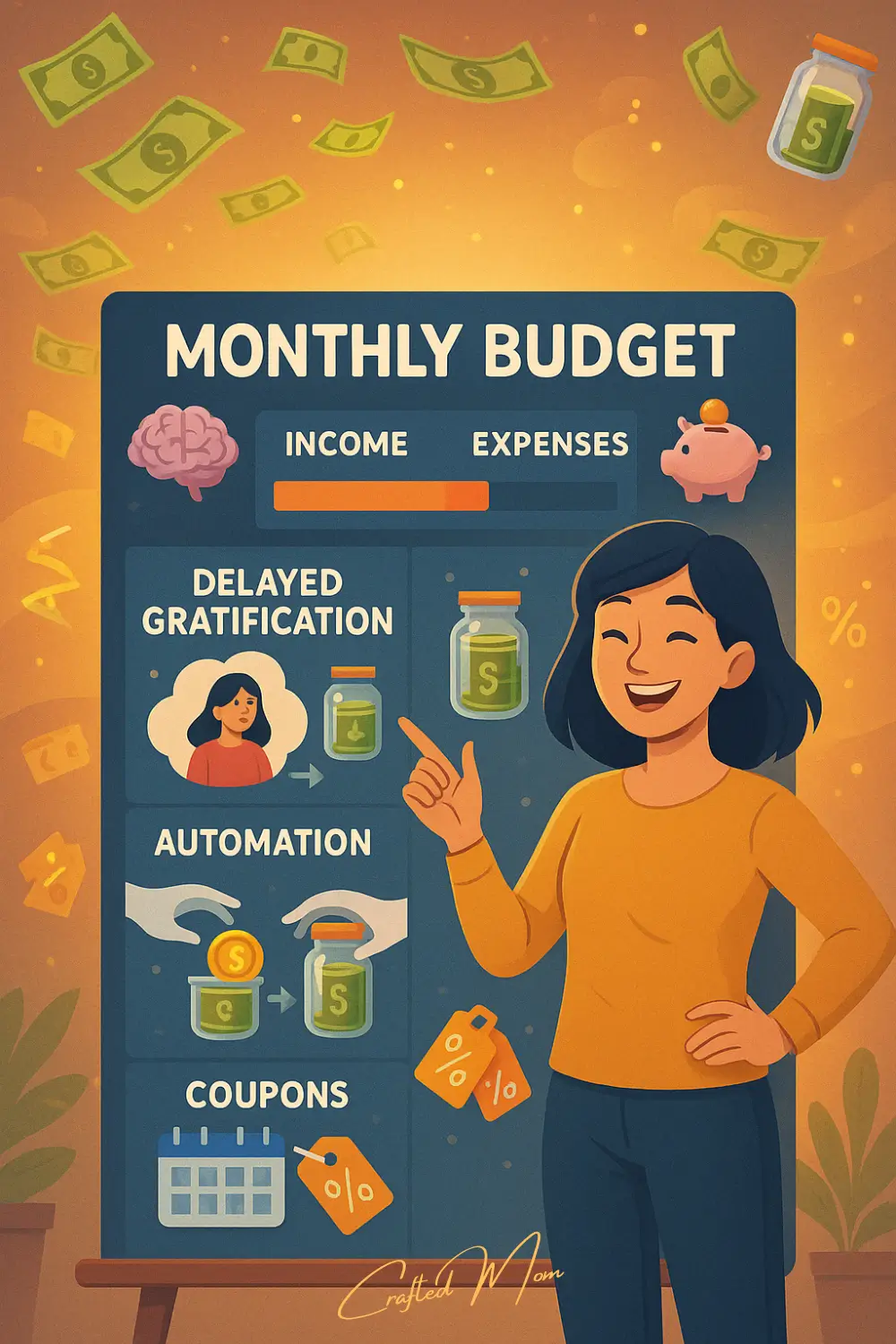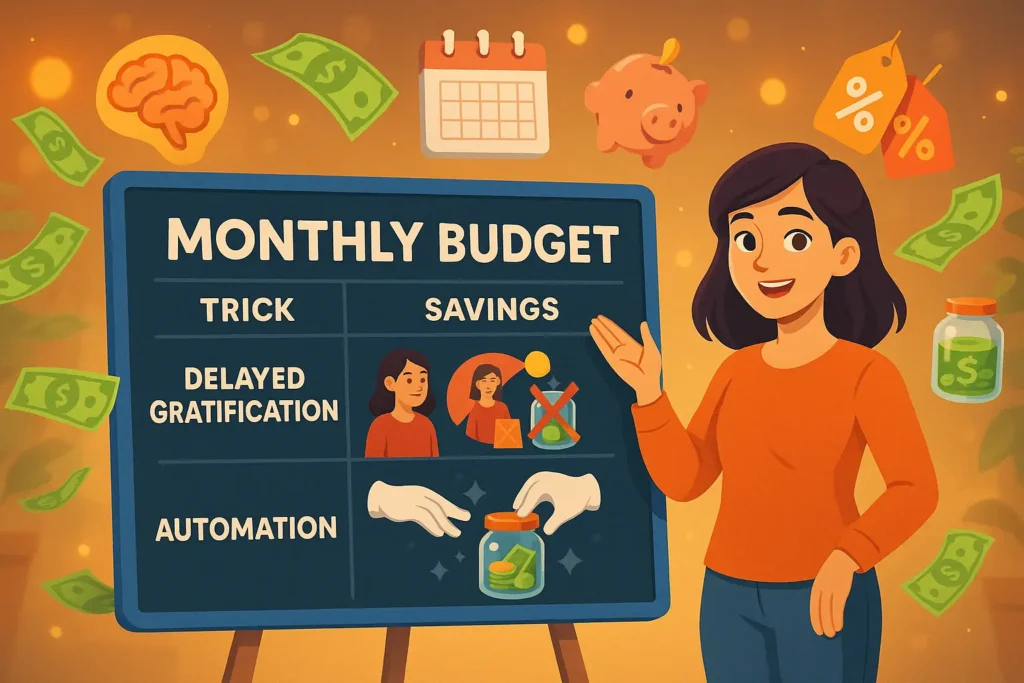Want to save more money without feeling like you’re living on ramen and regret? Good news, your brain can help. These science-backed money-saving strategies tap into how we actually think, spend, and (sometimes impulsively) shop.
Whether you’re trying to build a rainy-day fund, cut back on emotional spending, or just make smarter choices at Target (we’ve all been there), these tips are designed to make saving feel easy, and even a little fun.
Psychological Money Saving Tricks

Let’s dive into the psychological hacks that’ll help you spend less, save more, and stress way less.
1. Use Cash Instead of Cards
Ever notice how swiping your card feels… kind of like nothing? That’s because it is. Psychologically, using plastic doesn’t register the same way as handing over cold, hard cash.
Research shows that paying with physical money actually activates the pain centers in your brain, yep, your brain feels a little sting every time you part with paper bills. That emotional nudge makes you think twice about spending on things you don’t really need.
Why it works:
- Swiping a card is too easy, cash feels real
- You’re way more aware of what you’re spending
- You’ll hesitate before handing over that last $20
💡 Pro tip: Carry $100 bills instead of smaller ones. We’re psychologically less likely to break large denominations for small purchases (like that “just one more coffee” moment).
2. Set Up Automatic Deductions
Ever heard the phrase “out of sight, out of mind”? Well, it totally applies to your money too. When you automate your savings, you trick your brain in the best way possible, by never letting it “see” that money as spendable in the first place.
Why it works:
- Your brain doesn’t feel the loss if it never sees the cash hit your checking account
- No mental tug-of-war between saving and spending
- You build a habit without even thinking about it
💡 Pro tip: Set up automatic transfers to a separate savings account, one that’s just inconvenient enough to discourage impulse withdrawals. Bonus points if it earns interest.
3. Track Your Spending with Monthly Statements
You know that moment when you check your bank account and think, “Wait… where did all my money go?” Yeah, that’s your sign to start tracking.
As the great Peter Drucker said, “If you can’t measure it, you can’t manage it.” And honestly? Most of us are spending more than we think, because we’re not paying attention.
Why it works:
- Writing it down forces accountability
- It highlights where your money’s actually going
- Just knowing you have to log that $18 coffee run? Enough to stop you in your tracks
💡 Build a simple balance sheet each month with:
- Fixed expenses (rent, utilities, loans, savings)
- Variable expenses (gas, groceries, takeout, random Target runs)
- All income sources (paychecks, side hustles, etc.)
Then, subtract total expenses from income. Boom, monthly profit or deficit. It’s not fancy, but it’s eye-opening. And once you see those numbers in black and white, your spending habits start to shift real fast.
4. Avoid Advertising and Triggers
Ever opened an email “just to browse,” and 10 minutes later you’re tracking a package you didn’t plan on ordering? Same. That’s because modern ads are crafted to light up the part of your brain that screams “I need this!” even when you totally don’t.
Why it works:
- Your brain can’t crave what it doesn’t see
- Fewer visual cues = fewer buying impulses
- You reclaim control over your attention (and your wallet)
💡 Start here:
- Unsubscribe from promo emails, you’re not missing out
- Use an ad blocker online
- Skip the impulse-buy traps in checkout lanes (looking at you, mystery snacks and mini candles)
This is classic behavioral psychology: when you remove the trigger, the habit starts to break. Less exposure means fewer “ooooh, I want that” moments, and more room for intentional, guilt-free spending.
5. Embrace “Now vs Later” Thinking
Impulse buys? They feel amazing in the moment… until your package arrives and you’re like, “Why did I think I needed this electric cheese grater?”
That’s where “now vs later” thinking swoops in to save your savings.
Why it works:
- Your brain is wired for instant gratification, but it can be trained
- The longer you wait, the less emotionally attached you feel
- Most of the time? You’ll either lose interest or find something better (or cheaper)
💡 Try this: When you’re tempted by a non-essential (think: gadgets, clothes, cute-but-unnecessary home decor), wait at least a week. If you’re still thinking about it after that? It might actually be worth it.
Some people even keep a “want list”, and revisit it once a month. You’d be shocked how many things you no longer actually want after giving it some space.
6. Convert Prices Into Work Hours
Here’s a question that’ll stop you mid-splurge: “Would I actually work 5 hours just to buy this $50 shirt?” 😬
When you look at price tags in work hours instead of dollars, your brain gets a whole new perspective on value. It’s not just about money, it’s about time.
Why it works:
- Time feels more personal than money, it’s literally your life energy
- Makes you think twice about impulse buys
- Helps you prioritize what’s truly worth it
🧠 Try this trick: Take the item’s price and divide it by your hourly wage (after taxes). That’s how long you’d have to work to pay for it. Suddenly, those $8 lattes or $200 headphones hit very different.
So next time you’re eyeing something shiny, ask yourself: “Is this worth three hours of my time… or nah?”
It’s one of the easiest ways to spend smarter without budgeting down to the penny, and it really changes how you shop.
7. Focus on Making More, Not Just Spending Less
Saving money is smart, but earning more? That’s a power move. Instead of constantly trimming your grocery list and skipping date nights, shift your focus to bringing in extra cash. It’s a mindset shift, and honestly, it changes everything.
Why it works:
- Your brain thrives on abundance thinking, not restriction
- Earning more creates momentum and confidence
- It’s often easier to add $300/month than slash it from your current lifestyle
💡 Start small:
- Offer a service you’re good at (hello, freelancing!)
- Launch a weekend side hustle
- Ask for that raise you’ve earned
- Sell your clutter (because yes, that counts too)
When you prioritize increasing income, you give yourself more flexibility, less financial stress, and way more freedom. It’s not about hustle culture, it’s about building options.
Final Thoughts on Psychological Money Saving Tricks
Saving money isn’t about extreme couponing or living off instant noodles, it’s about building smarter habits rooted in how your brain actually works. When you understand the psychology behind your spending, you stop relying on willpower and start making choices that feel intentional, not restrictive. For a more structured approach to managing your finances, check out our Budgeting for moms: A Step-By-Step Guide to help you stay on track with ease.
So whether you’re switching to cash, tracking your spending, or finally launching that side hustle, remember: small shifts in mindset can lead to big results.
💬 Which of these tricks are you going to try first?
Drop your thoughts in the comments, or share this post with someone who’s ready to save smarter, not harder.

Frequently Asked Questions:
How does mental accounting influence my spending habits?
Mental accounting involves categorizing money into different “accounts” (e.g., entertainment, bills). This can lead to irrational spending, as people might splurge in one category while being frugal in another, even if funds are tight overall.
Can setting short-term savings goals improve my saving behavior?
Yes. Focusing on short-term goals makes saving more tangible and achievable, increasing the likelihood of success.
What is the ‘sunk cost fallacy,’ and how does it affect my finances?
The sunk cost fallacy is the tendency to continue investing in something because of prior investments, even if it’s no longer beneficial. This can lead to continued spending on unworthy expenses.

